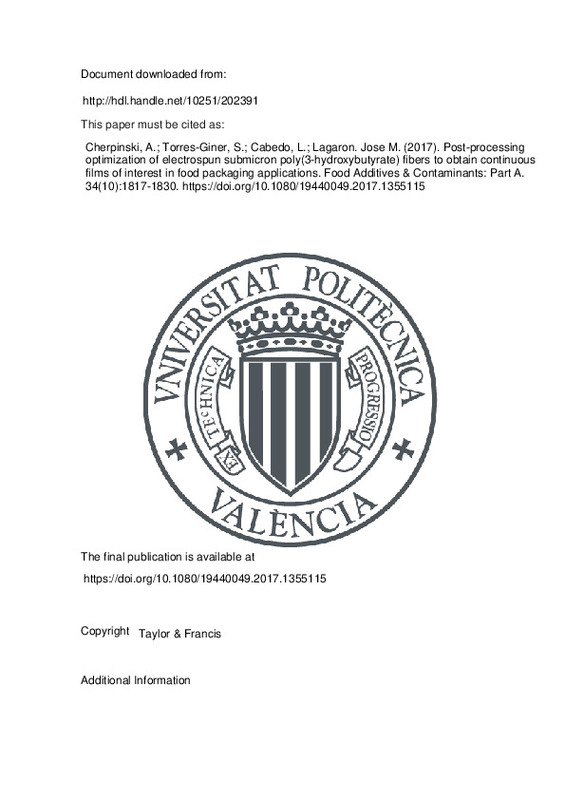JavaScript is disabled for your browser. Some features of this site may not work without it.
Buscar en RiuNet
Listar
Mi cuenta
Estadísticas
Ayuda RiuNet
Admin. UPV
Post-processing optimization of electrospun submicron poly(3-hydroxybutyrate) fibers to obtain continuous films of interest in food packaging applications
Mostrar el registro sencillo del ítem
Ficheros en el ítem
| dc.contributor.author | Cherpinski, Adriane
|
es_ES |
| dc.contributor.author | Torres-Giner, Sergio
|
es_ES |
| dc.contributor.author | Cabedo, Luis
|
es_ES |
| dc.contributor.author | Lagaron. Jose M.
|
es_ES |
| dc.date.accessioned | 2024-02-07T19:01:54Z | |
| dc.date.available | 2024-02-07T19:01:54Z | |
| dc.date.issued | 2017 | es_ES |
| dc.identifier.issn | 1944-0049 | es_ES |
| dc.identifier.uri | http://hdl.handle.net/10251/202391 | |
| dc.description.abstract | [EN] Polyhydroxyalkanoates (PHAs) are one of the most researched family of biodegradable polymers based on renewable materials due to their thermoplastic nature and moisture resistance. The present study was targeted to investigate the preparation and characterization of poly(3-hydroxybutyrate) (PHB) films obtained through the electrospinning technique. To convert them into continuous films and then to increase their application interest in packaging, the electrospun fiber mats were subsequently post-processed by different physical treatments. Thus, the effect of annealing time and cooling method on morphology, molecular order, thermal, optical, mechanical, and barrier properties of the electrospun submicron PHB fibers was studied. Annealing at 160°C, well below the homopolyester melting point, was found to be the minimum temperature at which homogeneous transparent films were produced. The film samples that were cooled slowly after annealing showed the lowest permeability to oxygen, water vapor, and limonene. The optimally post-processed electrospun PHB fibers exhibited similar rigidity to conventional compression-molded PHA films, but with enhanced elongation at break and toughness. Films made by this electrospinning technique have many potential applications, such as in the design of barrier layers, adhesive interlayers, and coatings for fiber- and plastic-based food packaging materials. | es_ES |
| dc.description.sponsorship | This work was supported by the Spanish Ministry of Economy and Competitiveness (MINECO) [Project AGL2015-63855-C2-1-R] and by the Brazilian Council for Scientific and Technological Development (CNPq) [Grant 205955/2014-2]. | es_ES |
| dc.language | Inglés | es_ES |
| dc.publisher | Taylor & Francis | es_ES |
| dc.relation.ispartof | Food Additives & Contaminants: Part A | es_ES |
| dc.rights | Reconocimiento - No comercial (by-nc) | es_ES |
| dc.subject | Barrier properties | es_ES |
| dc.subject | Coatings | es_ES |
| dc.subject | Electrospinning | es_ES |
| dc.subject | Packaging | es_ES |
| dc.subject | Polyhydroxyalkanoates | es_ES |
| dc.title | Post-processing optimization of electrospun submicron poly(3-hydroxybutyrate) fibers to obtain continuous films of interest in food packaging applications | es_ES |
| dc.type | Artículo | es_ES |
| dc.identifier.doi | 10.1080/19440049.2017.1355115 | es_ES |
| dc.relation.projectID | info:eu-repo/grantAgreement/MINECO//AGL2015-63855-C2-1-R/ES/DESARROLLO DE UN CONCEPTO DE ENVASE MULTICAPA ALIMENTARIO DE ALTA BARRERA Y CON CARACTER ACTIVO Y BIOACTIVO DERIVADO DE SUBPRODUCTOS ALIMENTARIOS/ | es_ES |
| dc.relation.projectID | info:eu-repo/grantAgreement/CNPq//205955%2F2014-2/ | es_ES |
| dc.rights.accessRights | Abierto | es_ES |
| dc.contributor.affiliation | Universitat Politècnica de València. Instituto Universitario de Ingeniería de Alimentos para el Desarrollo - Institut Universitari d'Enginyeria d'Aliments per al Desenvolupament | es_ES |
| dc.description.bibliographicCitation | Cherpinski, A.; Torres-Giner, S.; Cabedo, L.; Lagaron. Jose M. (2017). Post-processing optimization of electrospun submicron poly(3-hydroxybutyrate) fibers to obtain continuous films of interest in food packaging applications. Food Additives & Contaminants: Part A. 34(10):1817-1830. https://doi.org/10.1080/19440049.2017.1355115 | es_ES |
| dc.description.accrualMethod | S | es_ES |
| dc.relation.publisherversion | https://doi.org/10.1080/19440049.2017.1355115 | es_ES |
| dc.description.upvformatpinicio | 1817 | es_ES |
| dc.description.upvformatpfin | 1830 | es_ES |
| dc.type.version | info:eu-repo/semantics/publishedVersion | es_ES |
| dc.description.volume | 34 | es_ES |
| dc.description.issue | 10 | es_ES |
| dc.identifier.pmid | 28712345 | es_ES |
| dc.relation.pasarela | S\342015 | es_ES |
| dc.contributor.funder | Ministerio de Economía y Competitividad | es_ES |
| dc.contributor.funder | Conselho Nacional de Desenvolvimento Científico e Tecnológico, Brasil | es_ES |







![[Cerrado]](/themes/UPV/images/candado.png)

